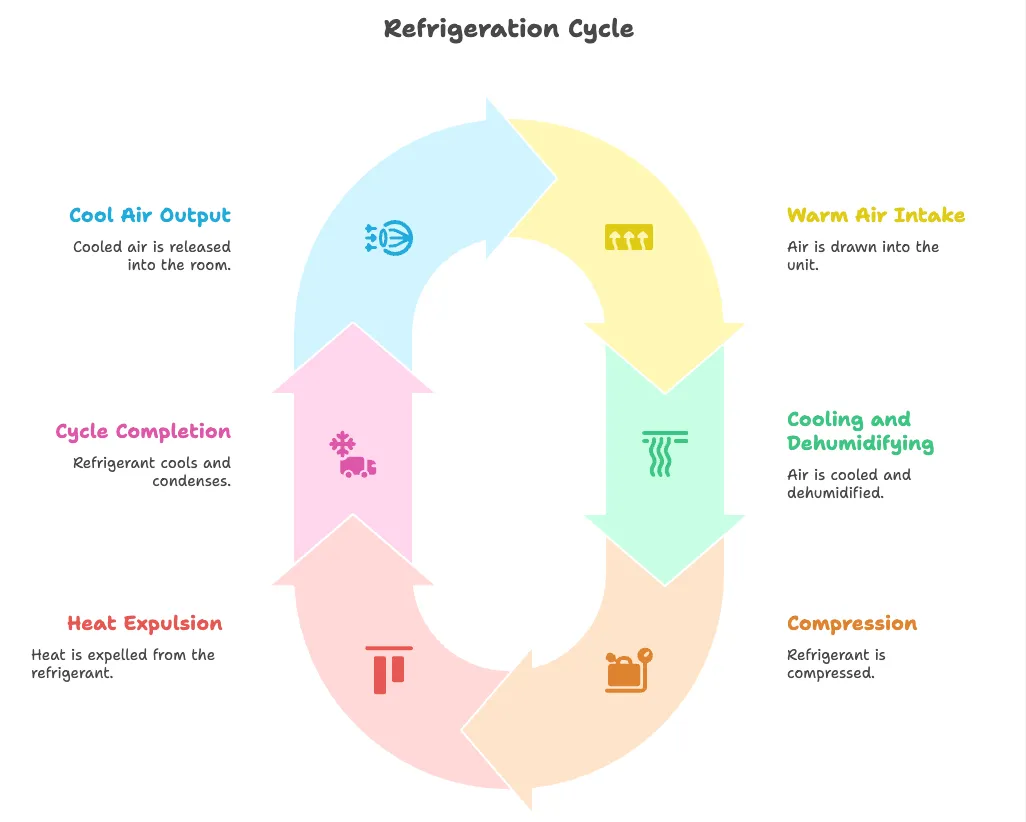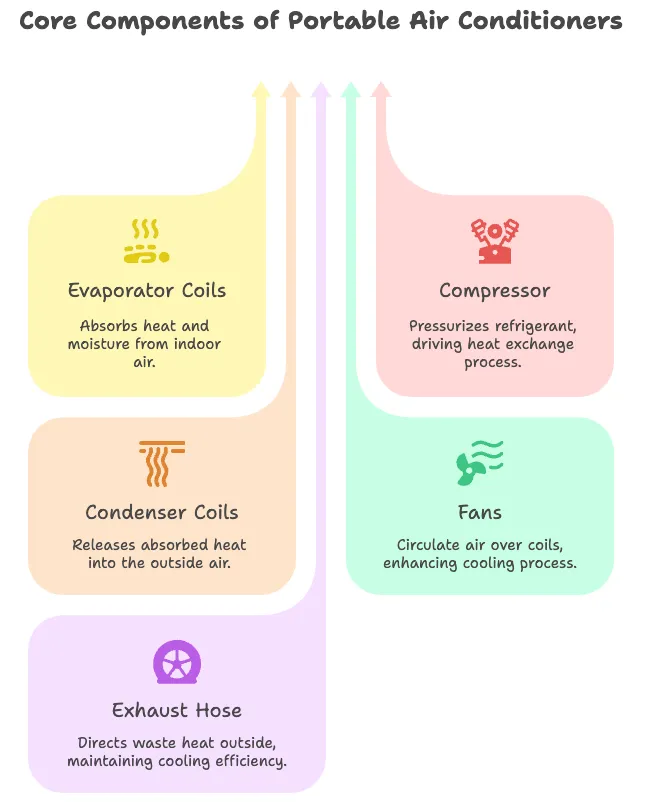What is a Portable Air Conditioner?
With UK summers getting hotter, portable air conditioners offer flexible, affordable cooling for any room. This guide covers everything you need to know about how they work, types available, and what to consider for UK homes.
The Fundamentals of Portable Air Conditioning
Quick Answer
A portable air conditioner is a self-contained, mobile cooling device designed to cool a single room. Its defining feature is "portability"—the unit is typically fitted with castors, allowing users to easily move it between rooms as needed.
How It Works: The Refrigeration Cycle
Key Insight
Portable air conditioners don't "create" cold air. They act as "heat movers," following the same refrigeration principles as large central systems to transfer heat from inside your room to the outside.
The 6-Step Refrigeration Process:
Warm Air Intake
A fan draws warm, humid air from the room into the machine through an intake vent
Cooling and Dehumidifying
Air flows over ice-cold evaporator coils containing refrigerant, absorbing heat and condensing moisture
Compression
The refrigerant gas is compressed, dramatically increasing its pressure and temperature
Heat Expulsion
Hot refrigerant moves to condenser coils where a fan expels the heat outside through the exhaust hose
Cycle Completion
Refrigerant cools, condenses back to liquid, and returns to evaporator coils
Cool Air Output
Cooled, dehumidified air is blown back into the room, lowering overall temperature

Core Components and Their Roles

Evaporator Coils
Front of unit
Acts like a 'heat sponge,' absorbing heat and moisture from room air
Compressor
Inside chassis
Power core that pressurizes refrigerant. Primary source of noise
Condenser Coils
Back of unit
Releases absorbed heat into air that will be vented outside
Fans (2 units)
Internal
One for indoor air circulation, another for condenser cooling
Exhaust Hose
External
Crucial tube directing waste heat outside through window
The All-in-One Compromise
The "convenience" of portable AC is achieved at the cost of "efficiency" and "quietness." Unlike split systems, all heat-generating components must sit inside your room.
Single-Hose vs. Dual-Hose: A Crucial Choice
Single-Hose Models
Most common and affordable type. Uses one exhaust hose to vent waste heat outside, but also uses precious cooled indoor air to cool internal components.
⚠️ The Negative Pressure Problem
Creates vacuum effect, sucking hot outdoor air into the room through gaps, directly counteracting cooling efforts.
Advantages:
- • Lower upfront cost
- • Simpler installation
- • More portable design
Disadvantages:
- • Lower cooling efficiency
- • Higher energy consumption
- • Constant hot air infiltration
Best for: Small rooms (under 400 sq ft), mild climates, budget-conscious buyers, occasional use
Dual-Hose Models
Advanced design with separate intake and exhaust hoses. Creates closed external loop for cooling internal components, solving negative pressure problem.
✅ The Efficiency Advantage
Up to 40% faster cooling! All cooled air stays inside the room, no mixing with outside air.
Advantages:
- • Superior cooling efficiency
- • Lower energy consumption
- • No pressure imbalance
Disadvantages:
- • Higher upfront cost
- • More complex installation
- • More window space required
Best for: Large rooms, hot climates, efficiency-focused users, long-term use
Head-to-Head Comparison
| Feature | Single-Hose | Dual-Hose |
|---|---|---|
| How it Works | Uses indoor air to cool room AND unit | Separate hoses for intake and exhaust |
| Room Air Pressure | Creates negative pressure | Pressure remains balanced |
| Cooling Efficiency | Lower - fights hot air influx | Higher - up to 40% faster |
| Energy Efficiency | Lower - unit works harder | Higher - less energy wasted |
| Upfront Cost | Generally lower | Generally higher |
| Installation | Simpler - one hose | More complex - two hoses |
💡 The Hidden Cost Behind Simplicity
With UK's high electricity prices, the seemingly cheaper single-hose model may be a false economy. The extra upfront investment for dual-hose could be recouped in electricity savings over a few years, while enjoying faster, more effective cooling.
UK-Specific Considerations
Window Compatibility
Sash Windows
Common in UK homes, may need special adapters or custom installation kits
Casement Windows
Work well with standard window kits, easier installation
UPVC Windows
Need secure mounting, ensure weight support
Listed Buildings
May have restrictions on external modifications
UK Climate & Energy
Cooling Capacity
Summer peaks require 8,000-12,000 BTU for typical UK rooms
Humidity Control
High UK humidity makes dehumidification crucial for comfort
Variable Weather
Portable units ideal for unpredictable UK summer weather
Energy Costs
High electricity prices make efficiency ratings crucial
Installation Requirements
Space Requirements
- • 18-24" clearance around unit
- • Level floor surface
- • Access to suitable window
- • Drainage area nearby
- • Ventilation for heat dissipation
Electrical Needs
- • Standard 13A socket
- • Dedicated circuit preferred
- • GFCI protection recommended
- • Avoid extension cords
- • Check total load capacity
Tools Required
- • Screwdriver set
- • Measuring tape
- • Spirit level
- • Utility knife
- • Window kit components
Portable AC vs Other Options
| Feature | Portable AC | Window AC | Split System |
|---|---|---|---|
| Installation | ✅ Easy DIY | ⚠️ Moderate | ❌ Professional Required |
| Portability | ✅ High | ❌ Fixed Location | ❌ Permanent |
| Efficiency | ⚠️ Moderate | ✅ Good | ✅ Excellent |
| Cost Range | ✅ £200-600 | ✅ £150-500 | ❌ £800-2000+ |
| Rental Friendly | ✅ Yes | ⚠️ Maybe | ❌ No |
| Noise Level | ⚠️ Moderate-High | ⚠️ Moderate | ✅ Low |
When to Choose a Portable Air Conditioner
Portable AC is Perfect If:
- •You're renting and can't make permanent changes
- •You need cooling in different rooms at different times
- •Your windows aren't suitable for window units
- •You want a quick, temporary cooling solution
- •Your home lacks central air conditioning
- •You're testing cooling needs before permanent installation
- •You have restrictive building covenants
Consider Alternatives If:
- •You need to cool very large spaces (over 500 sq ft)
- •Energy efficiency is your top priority
- •You want the quietest possible operation
- •You need year-round climate control
- •You have suitable windows for window units
- •Budget allows for split system installation
- •You require maximum cooling efficiency
Ready to Find Your Perfect Portable AC?
Now that you understand portable air conditioners completely, discover our expert recommendations for UK homes